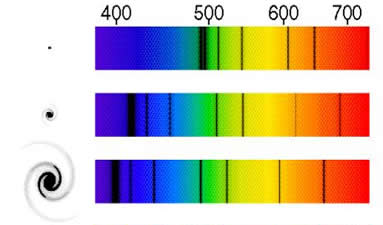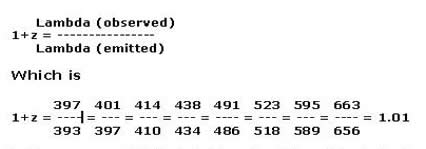4.Measurement of Red shift of galaxy / star
Red and blue shifts
Light from moving objects will appear to have different wavelengths depending on the relative motion of the source and the observer.
Observers looking at an object that is moving away from them see light that has a longer wavelength than it had when it was emitted (a redshift), while observers looking at an approaching source see light that is shifted to shorter wavelength (a blueshift).

The schematic diagram above shows a galaxy at the bottom left with its spectrum on the bottom rightThese lines can be used to identify the chemical elements in distant stars, but they also tell us the radial velocity. The other two spectra and pictures from bottom to top show a nearby galaxy, a medium distance galaxy, and a distant galaxy. Notice how the pattern of absorption lines shifts to the red as the galaxies get fainter. The numbers above and below the spectra are the measured wavelengths in nm [nanometers].

In this case so z = 0.01 for the bright galaxy. The radial velocity is usually approximated by v(rad)=cz, where c is the speed of light, The medium bright galaxy is moving away at 15,000 km/sec with z = 0.05, while the faintest and most distant galaxy is moving away at 75,000 km/sec with z = 0.25.
By this, we can calculate the distance of galaxies too far from us.